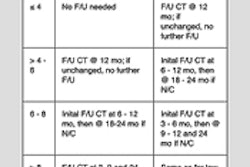Dear AuntMinnie Member,
The mantra "time is brain" has long been used in urging more rapid treatment of stroke victims. Could a variation on that theme also be accurate for individuals suspected of having traumatic brain injury (TBI)?
New research released today indicates that it might. A group from Walter Reed National Military Medical Center studied military personnel with TBI and found that MRI was useful in detecting evidence of cerebral microhemorrhages. But the modality's effectiveness dropped the longer it took to get an individual to the scanner.
That's a particular problem for the military, because injuries to soldiers frequently occur in remote locations with little or no access to medical imaging -- certainly not advanced imaging such as MRI. The researchers believe their findings could support the siting of MRI scanners near combat theaters.
Learn more by clicking here, or visit our MRI Community at mri.auntminnie.com.
Cutting unnecessary wrist x-rays
At the other end of the spectrum, there's been a plethora of news lately in medical imaging's oldest modality, radiography.
Dutch researchers have developed a clinical decision model for assessing pediatric wrist trauma that they believe could cut unnecessary emergency x-ray imaging by 22%. The development of the model is especially critical given the high number of wrist injuries, which has led to costs of more than $2 billion per year as x-rays are being used more often to diagnose hurt kids.
The decision model aims to cut down on the high number of normal radiographs following trauma by using six criteria for determining whether a wrist radiograph should be acquired. Find out what they are by clicking here.
Digital tomo disappoints
Digital tomosynthesis (that is, tomo performed for applications other than the breast) has been generating interest for at least the past decade as a possible intermediary modality between conventional radiography and CT. But a new study from the Mayo Clinic in Rochester, MN, indicates that it might not be the best choice for assessing and characterizing lung nodules.
The researchers compared digital tomo with conventional chest radiography in a group of 82 individuals with suspected lung pathology. They found that while tomo performed much better than radiography, it fell far short of CT. The findings raise the question of why patients shouldn't just be sent straight to CT. Learn more by clicking here.
Finally, click here to learn how researchers from the University of California, Los Angeles reduced unnecessary x-rays for pelvic trauma.
These stories and more are available in our Digital X-Ray Community at xray.auntminnie.com.



















